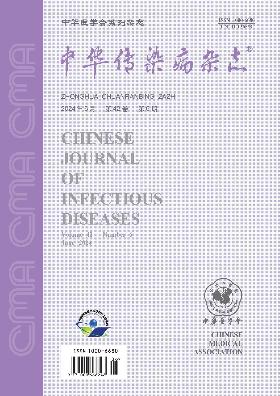Clinical features and prognostic factors in patients with liver abscess and acquired immunodeficiency syndrome
引用次数: 0
Abstract
Objective To investigate the clinical features and prognostic factors in patients with acquired immunodeficiency syndrome (AIDS) and liver abscess. Methods The clinical data of AIDS patients with liver abscess admitted in Beijing You-an Hospital during January 2013 to December 2017 were retrospective analyzed to reveal the clinical manifestations, etiologies, imaging features, therapeutic effects and prognostic factors. T test, χ2 test or Fisher exact test were used for statistical analyses. Results A total of 76 patients were recruited. The most common clinical manifestations were fever (72 cases), chills (48 cases), anorexia (42 cases) and abdominal pain (35 cases). Liver abscesses were mainly located in right lobe (57 cases), then in left lobe (11 cases), in both right and left lobes (6 cases) and in caudate lobe (2 cases). Lobulation or division was seen in 19 cases and gas formation was seen in 5 cases. Single abscess was identified in 56 cases. Positive culture results were obtained in 15.5% (9/58) from liver pus and 6.0% (4/67) from blood samples. Thirteen strains of pathogens were detected by liver pus culture, including 9 strains of Staphylococcus, 3 strains of Candida and 1 strain of Mycobacterium. Six strains of pathogens were detected by blood culture, including 5 strains of Staphylococcus and 1 strain of Corynebacterium. The main complications included acute kidney injury (10 cases) and septic shock (6 cases). Sixty-one cases were treated with antibiotics plus imaging-guided percutaneous aspiration, drainage or surgery, of whom 57 cases were effective. Fifteen cases were treated with antibiotics alone, of whom 12 cases were effective. Septic shock (OR=70.16, 95%CI: 4.77-1 032.06, P<0.01), respiratory failure (OR=68.41, 95%CI: 2.40-1 946.53, P=0.01) and gas formation (OR=23.36, 95%CI: 1.30-420.16, P=0.03) were independent risk factors for poor prognosis. Conclusions The clinical features of AIDS patients with liver abscess are uncharacteristic. Bacteria are the main pathogens. Septic shock, respiratory failure and gas formation are independent risk factors for poor prognosis. Imaging-guided percutaneous aspiration, drainage combined with antibiotic therapy is safe and effective. Key words: Acquired immunodeficiency syndrome; Liver abscess; Prognosis; Clinical feature; Treatment肝脓肿合并获得性免疫缺陷综合征的临床特点及预后因素分析
目的探讨艾滋病合并肝脓肿的临床特点及影响预后的因素。方法对北京佑安医院2013年1月至2017年12月收治的艾滋病肝脓肿患者的临床资料进行回顾性分析,揭示其临床表现、病因、影像学特点、治疗效果及预后因素。采用T检验、χ2检验或Fisher精确检验进行统计分析。结果共招募76名患者。最常见的临床表现为发热(72例)、发冷(48例)、厌食(42例)和腹痛(35例)。肝脓肿主要位于右叶(57例),然后是左叶(11例),左右叶各6例,尾状叶2例。小叶或分裂19例,气体形成5例。56例中发现单个脓肿。肝脓液培养阳性率为15.5%(9/58),血液培养阳性率6.0%(4/67)。肝脓液培养共检出病原菌13株,其中葡萄球菌9株,念珠菌3株,分枝杆菌1株。血培养共检出6株病原菌,其中葡萄球菌5株,棒状杆菌1株。主要并发症包括急性肾损伤(10例)和感染性休克(6例)。61例采用抗生素加影像学引导下经皮穿刺、引流或手术治疗,其中57例有效。单用抗生素治疗15例,其中12例有效。败血症休克(OR=70.16,95%CI:4.77-1032.06,P<0.01)、呼吸衰竭(OR=68.41,95%CI:2.40-1946.53,P=0.01)和气体形成(OR=23.36,95%CI:1.30-420.16,P=0.03)是预后不良的独立危险因素。结论艾滋病合并肝脓肿的临床特点不典型。细菌是主要的病原体。败血症休克、呼吸衰竭和气体形成是预后不良的独立危险因素。影像学引导下经皮穿刺引流联合抗生素治疗是安全有效的。关键词:获得性免疫缺陷综合症;肝脓肿;预后;临床特征;治疗
本文章由计算机程序翻译,如有差异,请以英文原文为准。
求助全文
约1分钟内获得全文
求助全文
来源期刊
自引率
0.00%
发文量
5280
期刊介绍:
The Chinese Journal of Infectious Diseases was founded in February 1983. It is an academic journal on infectious diseases supervised by the China Association for Science and Technology, sponsored by the Chinese Medical Association, and hosted by the Shanghai Medical Association. The journal targets infectious disease physicians as its main readers, taking into account physicians of other interdisciplinary disciplines, and timely reports on leading scientific research results and clinical diagnosis and treatment experience in the field of infectious diseases, as well as basic theoretical research that has a guiding role in the clinical practice of infectious diseases and is closely integrated with the actual clinical practice of infectious diseases. Columns include reviews (including editor-in-chief reviews), expert lectures, consensus and guidelines (including interpretations), monographs, short monographs, academic debates, epidemic news, international dynamics, case reports, reviews, lectures, meeting minutes, etc.

 求助内容:
求助内容: 应助结果提醒方式:
应助结果提醒方式:


